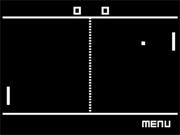 Pong players: free your mind and the bat will follow.© Getty
Pong players: free your mind and the bat will follow.© GettyNeuroscientists have created a computer game based on table tennis that people can play using nothing more than the power of their minds. It is hoped that the technology will one day train people to generate neural signals that could control a wheelchair or communication device.
Each 'brain pong' player lies in a functional magnetic resonance imaging (fMRI) machine, usually reserved for medical brain scans. After a short period of training, the players are able to make their ping-pong bat move up and down the screen by concentrating on specific thoughts. Sophisticated data analysis software makes the system responsive enough for two players to compete in real time.
"It's exciting that for the first time we have two subjects whose brains are interacting like this," says Rainer Goebel, a neuroscientist at Maastricht University in the Netherlands, who described the work on 27 August at the EuroScience Open Forum in Stockholm, Sweden.
Other researchers have shown that it is possible to control cursors on a computer screen by detecting electrical signals from the brain. But this is the first two-player game that exploits brain activity. The improved sensitivity of fMRI also makes it much easier to learn to control the bat, says Goebel.
Intensive training
Functional MRI works by picking up tiny magnetic signals from oxygen bound to iron dissolved in the bloodstream. As brain activity increases in a particular area, the blood flow increases, bringing more oxygen with it and increasing the signal strength. The technique can measure specific areas of the brain with millimetric accuracy, and most subjects proved adept at switching thoughts 'on' and 'off' after just three 45-minute training sessions.
 Using only brain signals, the best players can successfully return four out of five balls.© Friendspoint Games
Using only brain signals, the best players can successfully return four out of five balls.© Friendspoint GamesGoebel and his colleagues hope that the new technology could help paraplegic people to train the activity of a localized area of their brains, generating signals that could steer a wheelchair or work a communication device. Although fMRI machines are far too large to carry around, the training would help individuals to generate a clear signal that could then be detected using a more portable EEG machine.
The technology might even help people with mental disorders such as depression or schizophrenia, which are caused by excessive activity in parts of the brain. If patients were able to visualize the activity of troublesome brain areas, Goebel believes they could learn to steer their brains away from the patterns of activity that cause their symptoms.
Mental orchestra
The specific method of training varies from subject to subject. "We have to find the area of the brain that the subject can control best," explains Bettina Sorger, who worked with Goebel on the project. One option is to imagine faces, because there are particular, isolated areas of the brain that deal with such thoughts.
"But it can be really different from one person to the next. We have one subject, a musician, who can vividly imagine the sight and sound of a concert, and that's a very specific brain region," says Sorger.
If the musician wants the ping-pong bat to move up the screen, he adds more and more musicians to his mental orchestra, increasing the intensity of his vision to a crescendo. To move the bat back down the screen, he clears his mind of such thoughts until the bat rests at the base of the screen. It is just like visualizing a volume control, says Goebel.
